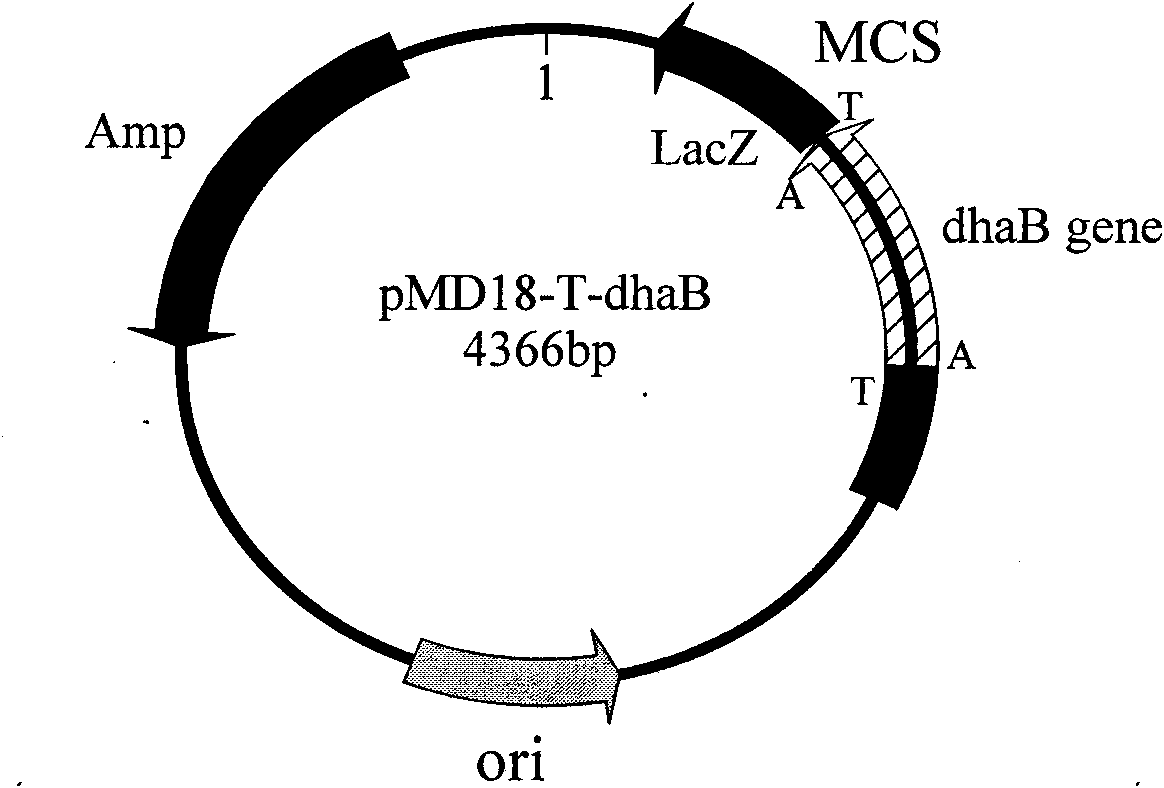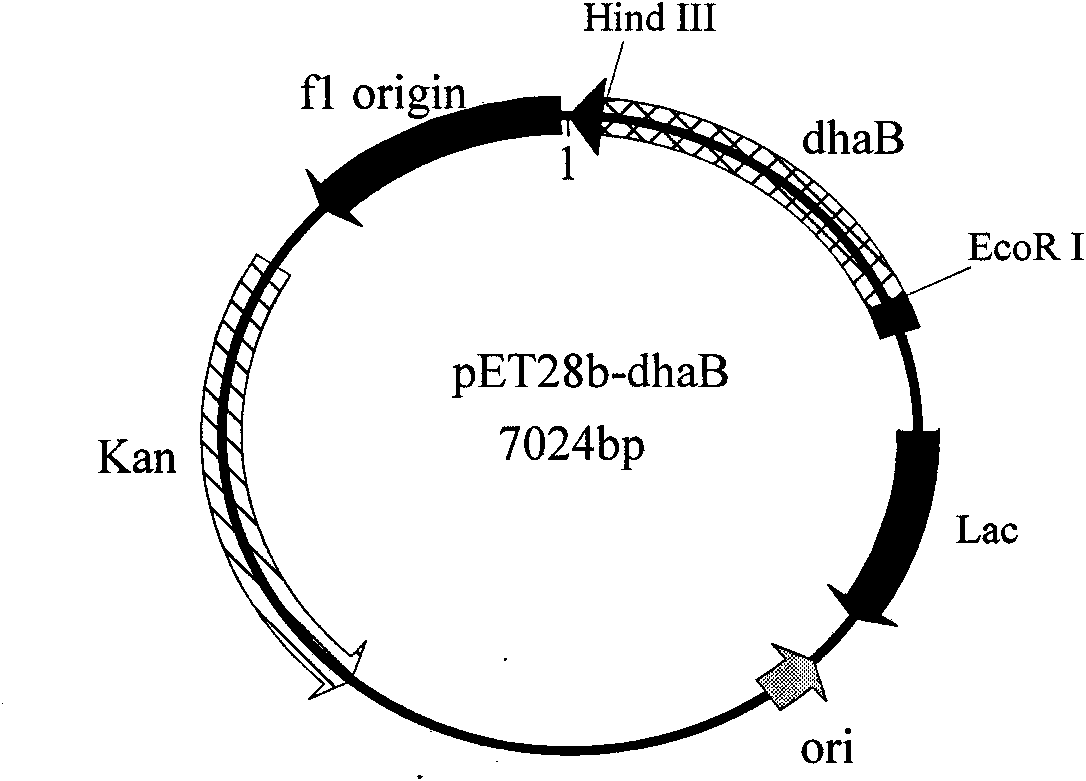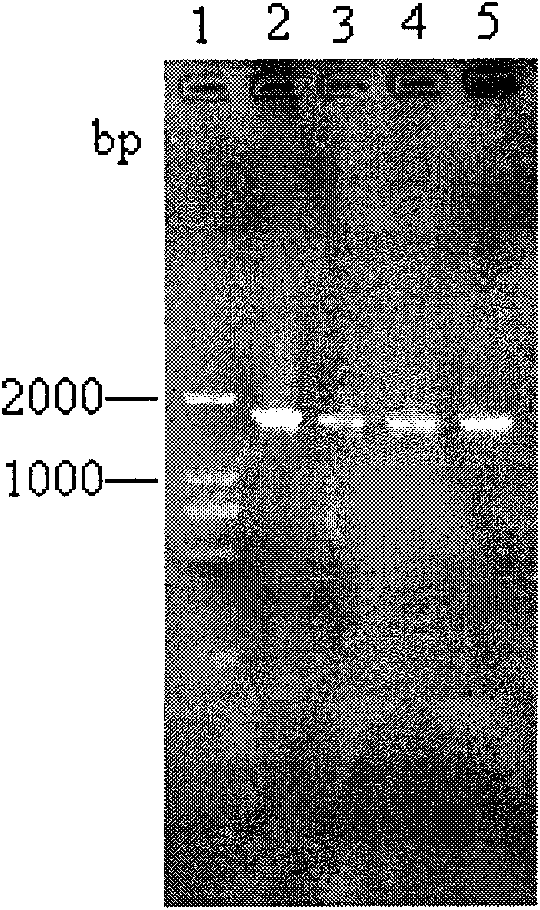Glycerol dehydratase gene, vector, engineering bacteria and application thereof
A technology of glycerol dehydratase and genetically engineered bacteria, which can be used in genetic engineering, application, plant genetic improvement, etc., and can solve the problems of low enzyme activity and high cost of coenzyme vitamin B12
- Summary
- Abstract
- Description
- Claims
- Application Information
AI Technical Summary
Problems solved by technology
Method used
Image
Examples
Embodiment 1
[0080] The total genomic DNA of Lactobacillus reuteriZJB-09105 strain (CCTCC NO: M 209213) was extracted with a rapid nucleic acid extractor, and the genomic DNA was used as a template in primer 1 (CAGTTCCAGGTGTTCCGG) and primer 2 (ATGAAACGCCAGAAACGCT). Under the effect of PCR amplification.
[0081] The amount of each component in the PCR reaction system (total volume 50 μL): 5 μL of 10×Pfu DNA Polymerase Buffer (TaKaRa), 1 μL of 10 mM dNTP mixture (2.5 mM each of dATP, dCTP, dGTP, and dTTP), cloning primer 1 and primer at a concentration of 50 μM 2 1 μL of each, 1 μL of genomic DNA, 1 μL of Pfu DNA Polymerase (TaKaRa), 40 μL of nucleic acid-free water.
[0082] Using Biorad’s PCR instrument, the PCR reaction conditions are: pre-denaturation at 94°C for 5 minutes, then enter the temperature cycle at 94°C for 30s, 55°C for 1.5min, and 72°C for 2min, a total of 35 cycles, and finally extend at 72°C for 10min, and the termination temperature is 8°C .
[0083] Take 5 μL of the ...
Embodiment 2
[0085] According to the analysis results of Example 1, expression primer 3 (GCCGAATTCATGAAACGCCAGAAACGCTTTGAAG) and primer 4 (AATAAGCTTCAGTTCCAGGTGTTCCGGATCCAGAG) were designed, and EcoRI and HindIII restriction enzyme sites were introduced in primer 3 and primer 4 respectively. Initiated by primers 3 and 4, the high-fidelity Pyrobest DNA polymerase was used to amplify to obtain a glycerol dehydratase gene fragment with a length of 1674bp. After sequencing, the amplified fragment was treated with EcoRI and HindIII restriction endonucleases. And use T4 DNA ligase to connect the fragment with the expression vector pET28b treated with the same restriction endonuclease to construct the expression vector pET28b-dhaB. The constructed expression vector pET28b-dhaB was electrotransformed into Escherichia coli BL21, spread on a plate and cultured at 37°C overnight, and the clones were randomly selected to extract the plasmids for enzyme digestion identification. The identification resul...
Embodiment 3
[0087] The recombinant Escherichia coli BL21 / pET28b-dhaB containing the expression recombinant plasmid pET28b-dhaB verified in Example 2 was cultured with LB liquid medium containing 50 μg / ml kanamycin resistance for 12 hours, and then inoculated with a volume ratio of 1%. Inoculate into fresh LB liquid medium containing 50 μg / ml kanamycin resistance, and cultivate to the cell concentration OD 600 About 0.6, then add IPTG with a final concentration of 0.5mM to the LB liquid medium, induce culture for 8 hours, centrifuge at 4°C, 5000rpm for 10min, and collect the bacterial cells containing recombinant glycerol dehydratase.
PUM
 Login to View More
Login to View More Abstract
Description
Claims
Application Information
 Login to View More
Login to View More - R&D
- Intellectual Property
- Life Sciences
- Materials
- Tech Scout
- Unparalleled Data Quality
- Higher Quality Content
- 60% Fewer Hallucinations
Browse by: Latest US Patents, China's latest patents, Technical Efficacy Thesaurus, Application Domain, Technology Topic, Popular Technical Reports.
© 2025 PatSnap. All rights reserved.Legal|Privacy policy|Modern Slavery Act Transparency Statement|Sitemap|About US| Contact US: help@patsnap.com



